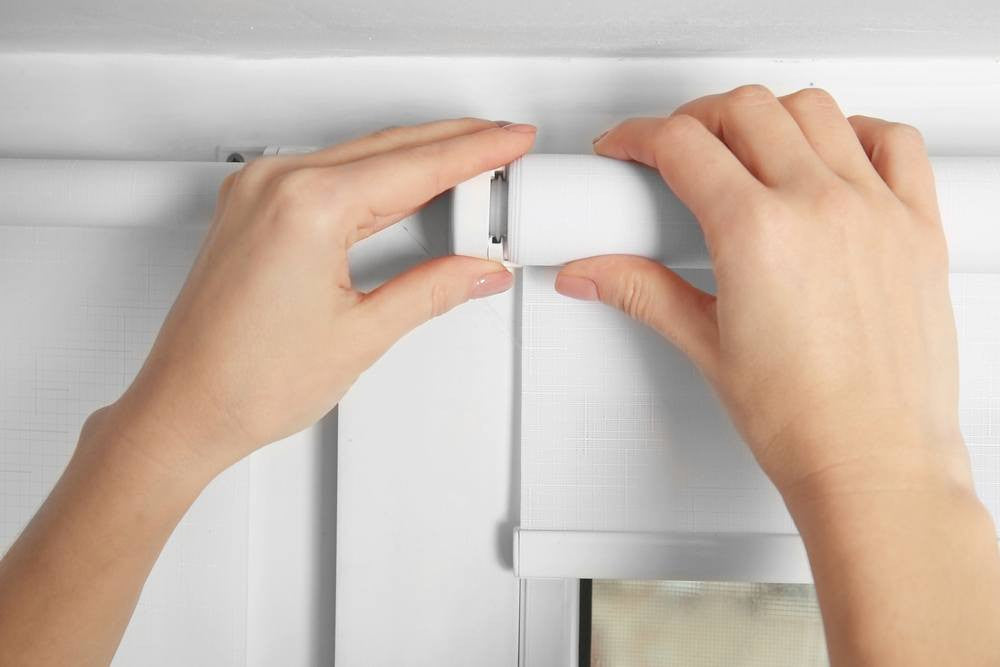
I have heard that Venetian blinds are notoriously hard to clean, which blinds are best for low maintenance and cleaning?
It is true that venetian blinds can be notorious to clean, this is because they have so many working parts, and small inaccessible grooves, cord slots and mechanisms. They also act as dust collectors attracting dirt and grime from the air onto slats, cords and into the mechanism. All of these factors mean that a venetian blind is not the best choice if you want a low maintenance window dressing.
Nevertheless below we have provided advice on the best cleaning techniques for venetian blinds. Study this closely as if you opt for a venetian blind then this is going to be part of your cleaning regime moving forward. If after reading you decide then this is not something you are willing to do, then we have included details of alternative blind options, which may be more to your liking.
Regular light cleaning
Although venetian blinds do need thoroughly cleaning, this only needs to be carried out annually. You can keep your blinds looking fresh and tidy by just doing some regular light cleaning, perhaps once a month. This is less thorough but is all that is needed to remove dust, loose dirt and everyday grime. 
This can be carried out using a duster, or if you prefer a vacuum cleaner. You will want to rotate the blind slats so that they are fully closed in one position (slats down), so that they are fully open and then fully closed in the other position (slats up). For each of these orientations you will want to take a duster and lightly dust the blind slats removing any loose pieces of dust or fluff. When the slats are in the open position (horizontal rather than at an angle) you will want to insert the duster between the slats to remove any additional pieces of dust. If you prefer you could use an anti-static or micro fibre cloth. These carry out the same function as a duster but they won't built up static on the slats, meaning the slats are less likely to attract dust within the air.
In fact, there is also a specially designed venetian blind cleaning device, that looks like kitchen tongues. These grip individual slats, cleaning the top and underneath simultaneously. They are quite nifty, but a duster or micro fibre cloth can be just as effective. Alternatively a lot of people use a vacuum cleaner, coupled with a special dusting nozzle. This will have soft bristles for dislodging dust, and shouldn't be too abrasive on blind slats. There are also specialist attachments designed specifically for this purpose. When using a vacuum cleaner just make sure that the suction isn't too strong, as on thin aluminium blinds this can cause them to bend, leading to obvious damage.
Thorough cleaning techniques
Here we cover some of the more in depth cleaning techniques that can be carried out less frequently, perhaps on a yearly basis. These methods are more thorough as they can involve taking the venetian blind out of the window, in order to give it a better clean using water.

Note: When it comes to cleaning wooden venetian blinds you should keep in mind that they are made from an absorbent wood, which in most cases cannot get wet. Any type of excessive moisture may cause warping or leave watermarks. Furthermore any stain or oil on the wooden slats can run and then streak when wet. So when cleaning wooden blinds it is recommended to stick to light cleaning, such as dusting without using any water or cleaning products. As mentioned above, a thorough cleaning will involve taking the blind out of the window.
So as a first step pull the blind cord to put the venetian blind into the closed position (all slats compacted directly under the headrail). Then unclip the mounting bracket of the venetian blind, both on the right and left side. The full blind should then slot out of the brackets and you will be able to remove it from the window. You will then want to submerge the blind into a bathtub containing lukewarm water. You might want to line the bath with a bath towel in order to prevent the tub from getting scratched, which can happen.
Add a cleaning solution to the water, one that will dissolve grease and grime. However it is always best to check the instructions of the blind, or ask the manufacturer for their specific suggestions on what cleaning products to use. Leave the blind to soak for about an hour and the grease, grime, dust and dirt should all come loose and dissolve into the water.
If after an hour you find that there is still grime on the blind then you may want to use a soft non-abrasive brush to gently remove additional dirt and grease. This technique can dislodge any stubborn dirt that may be fixed onto the blind slats. When doing this make sure to check both slides of the slat, as dirt is usually present on both sides, not just one. Once you are happy with the look of your blind and it is clean to your standard, then you will want to drain the bathtub. This will allow any dirt or grime to be washed away. It is then beneficial to fill the bathtub again with clean water, to completely rinse the blind clean. If you have access to a shower head then this can also be used here to ensure the blind is completely free of loose grime and dirt.
At this stage you need to make sure that the blind is completely dry before hanging back into your window. To do this you can extend the blind so that it is fully open and then leave it in the sun to allow any water to evaporate. Or you could use a micro-fibre cloth to remove as much moisture as you can. The reason that this is so important is that if you leave your blind fully closed whilst it is wet, then it can become mouldy. Once you are happy that the blind is fully dry you should then fit the blind back into the mounting brackets, and close the blind fully, positioning the slats to allow in as much light as possible. This will further dry out the blind and allow air to circulate through it fully.
Alternative low maintenance blind types
If you would prefer a low maintenance blind that doesn't require such a vigorous cleaning regime, then the best option is a roller blind. Roller blinds have few moving parts and less nooks and crannies to catch dust and grime. Plus if you have moisture resistance blinds, such as PVC blinds then you can easily wipe these clean with a damp cloth. These are an ideal blind if you think your blind is likely to be covered in spillages or from children's sticky fingers.

There are other blind options such as roman blinds or vertical blinds, but they both have their own specialist cleaning requirements. Vertical blinds catch dust in a similar way to vertical blinds, and roman blinds have multiple folds within the fabric that can catch dust as well. Roman blind fabric can be dry cleaned, or with the right fabric can be machine washed - but you will have to follow the specific instructions with your blind. So if you really want a hassle free blind, with minimal cleaning requirements then you really should go for the roller blind option.












